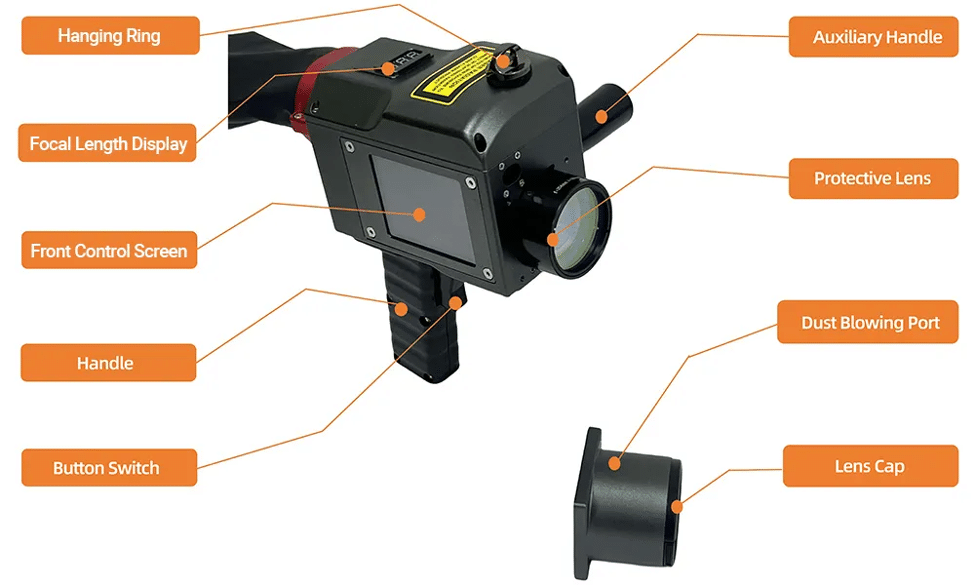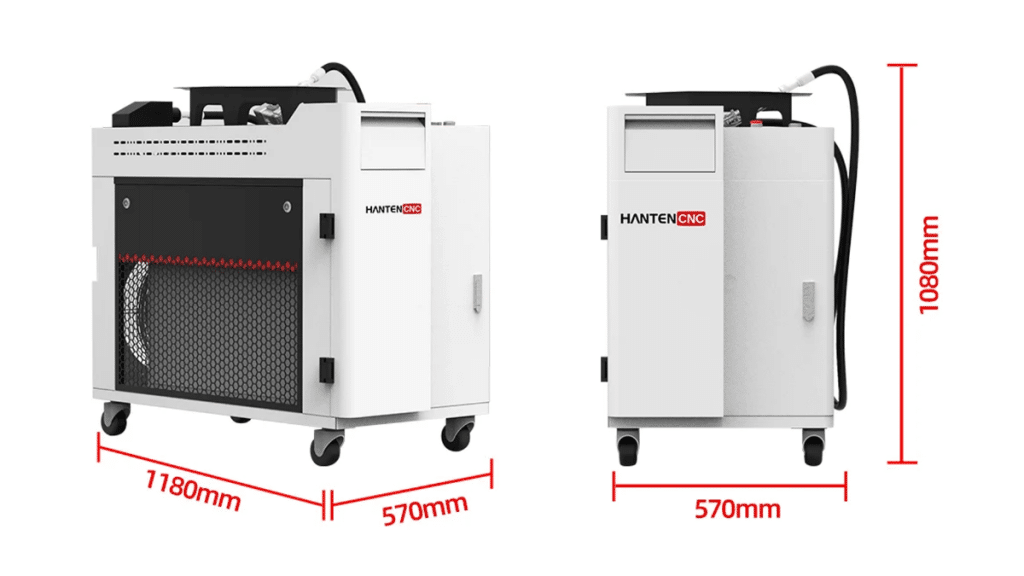The industrial sector is witnessing a paradigm shift in surface preparation and maintenance, driven by advancements in laser technology. Among these innovations, 500W handheld laser cleaning machine stand out for their precision, portability, and environmental benefits. In this article, we delve into how these machines work, their applications, and why brands like HANTENCNC are setting new standards in the industry.
What is Laser Cleaning?
Laser cleaning uses high-intensity pulsed laser beams to remove contaminants like rust, paint, oil, and oxides from surfaces. Unlike abrasive methods (e.g., sandblasting) or chemical treatments, it operates without physical contact, minimizing material damage and waste.
Key Advantages:
- Non-abrasive: Preserves substrate integrity.
- Eco-friendly: No toxic chemicals or secondary waste.
- Portable: Handheld units enable on-site cleaning in tight spaces.
Why 500W Power Matters?
A 500W handheld laser cleaning machine strikes the ideal balance between power and versatility. Here’s why this specification is ideal for industrial use:
- Speed: Cleans up to 2.5 m²/hour, reducing downtime.
- Adaptability: Adjustable settings handle light oxidation (e.g., car parts) to heavy rust (e.g., ship hulls).
- Energy Efficiency: Higher power doesn’t always mean higher consumption. Modern fiber lasers optimize energy use
Applications Across Industries
1. Automotive Manufacturing
Laser cleaning removes residues from molds, welding seams, and engine components, ensuring flawless coatings.
2. Aerospace
Delicate parts like turbine blades require non-invasive cleaning to avoid micro-damage.
3. Cultural Heritage
Museums use laser systems to restore artifacts without harming fragile surfaces.
4. Infrastructure Maintenance
Bridges, pipelines, and rail systems benefit from rust removal without abrasive methods.
Technical Features to Look For
When choosing a 500W handheld laser cleaning machine, prioritize these features:
| Feature | Importance |
| Cooling System | Air-cooled (portability) vs. water-cooled (stability for prolonged use). |
| Ergonomics | Lightweight design (<3 kg) reduces operator fatigue. |
| Pulse Frequency | Adjustable frequencies (20–2000 Hz) adapt to varying contamination levels. |
| Safety Mechanisms | Built-in sensors and protective eyewear compliance (e.g., CE, ISO 11553). |
Case Study: HANTENCNC’s Innovation in Laser Technology
HANTENCNC, a leader in laser solutions, has engineered handheld machines that address common industry challenges. Their 500W handheld laser cleaning machine lineup includes:
1. Seagull3 Air-Cooled Model
- Portability: Air-cooling eliminates bulky external systems.
- Applications: Ideal for outdoor maintenance (e.g., shipyards, construction sites).
2. Modular High-Power Model
- Integration: Compatible with robotic arms for automated production lines.
- Precision: Adjustable spot sizes (5–50 mm) for detailed work.
A recent study by Manufacturing Today highlighted that facilities using HANTENCNC’s systems reduced cleaning costs by 35% and waste by 90% compared to sandblasting.
Safety and Compliance
Modern laser systems prioritize operator safety. For instance, machines include:
- Class 4 Laser Safety: Enclosed beam paths and automatic shutdown.
- Fume Extraction: Optional filters capture airborne particles.
- Training Programs: On-site tutorials to ensure proper handling.
How to Choose the Right Model?
- Assess Workload: High-volume tasks may require water-cooled systems.
- Check Compatibility: Ensure the machine works with your materials (e.g., steel, aluminum).
- Evaluate Support: Opt for brands offering warranties and spare parts.
Future Trends in Laser Cleaning
- AI Integration: Smart sensors to auto-adjust power based on surface conditions.
- Battery-Powered Units: Enhanced mobility for remote sites.
- Lower Costs: As adoption grows, prices are expected to drop by 15–20% by 2026.

FAQs About Handheld Laser Cleaning Machines
1. How does a 500W handheld laser cleaning machine work?
The machine emits short, high-intensity laser pulses that vaporize contaminants like rust, paint, or grease without damaging the underlying material. The process is non-abrasive and requires no chemicals, making it ideal for delicate surfaces.
2. Are these machines safe for operators?
Yes. Reputable models, such as those from HANTENCNC, comply with ISO 11553 and CE safety standards. They include features like protective eyewear requirements, fume extraction options, and automatic shutdown mechanisms to minimize risks.
3. What industries benefit most from this technology?
Automotive, aerospace, shipbuilding, heritage conservation, and infrastructure maintenance are key adopters. The 500W handheld laser cleaning machine is versatile enough to handle tasks ranging from mold cleaning in factories to rust removal on bridges.
4. How does the cost compare to traditional methods like sandblasting?
While the upfront cost is higher, laser cleaning reduces long-term expenses by eliminating waste disposal fees, lowering labor costs, and minimizing equipment wear. Studies show a 35–60% reduction in total maintenance costs over three years.
5. What is the lifespan of a 500W handheld laser cleaning machine?
With proper maintenance, the fiber laser source can last over 100,000 hours. Regular upkeep, such as cleaning lenses and ensuring proper cooling, extends the machine’s operational life.
6. Can it handle heavy rust or thick paint layers?
Yes. Adjustable power settings (up to 500W) and pulse frequencies allow the machine to remove rust layers up to 0.3 mm thick and stubborn coatings. For extreme cases, multiple passes may be required.
Final Thoughts
The 500W handheld laser cleaning machine is redefining industrial maintenance, offering unmatched precision and sustainability. Brands like HANTENCNC are at the forefront, delivering robust solutions that align with modern environmental and efficiency standards.
For businesses seeking to modernize their operations, investing in this technology isn’t just a trend—it’s a strategic advantage.
